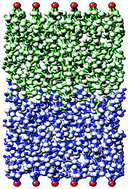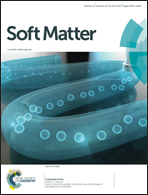Compression of polymer brushes in the weak interpenetration regime: scaling theory and molecular dynamics simulations
Abstract
We employ scaling theory and Molecular Dynamics (MD) simulations to probe the compression of the semi-dilute polymer brush bilayers (BBLs) in the weak interpenetration (IP) regime. Such a regime is characterized by two layers of interacting polymer brushes grafted on opposing planar surfaces having a separation dg, such that d0 < dg < 2d0, with d0 being the unperturbed brush height. Currently, scaling theories are known for polymer BBLs with a much larger degree of IP (i.e., dg < d0) – in such regimes, the brush height can be quantified by the corresponding IP length δ. On the other hand, we show that in the weak IP regime, the brush height is not solely dictated by δ. We develop new scaling theories to show that δ in this weak IP regime is different from that in the strong IP regime. Secondly, we establish that the compressed brush height in this weakly IP regime can be described as d ∼ Nχ with χ < 1 and varying monotonically with dg/d0. MD simulations are carried out to quantify δ and χ and the results match excellently with our new scaling theory predictions. Finally, we establish that our scaling theory can reasonably predict the experimentally witnessed variation of the interaction energy dictating the compressive force between the interpenetrating brushes in this weakly IP regime.



 Please wait while we load your content...
Please wait while we load your content...